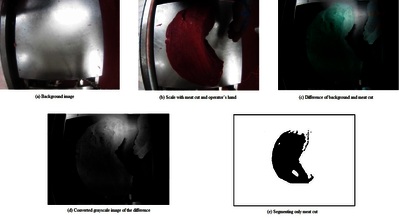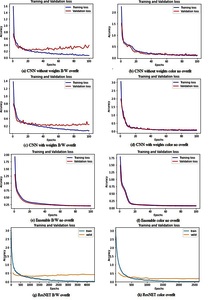Prakash, Satya  ORCID: 0000-0003-3977-4858, Berry, Donagh P., Roantree, Mark
ORCID: 0000-0003-3977-4858, Berry, Donagh P., Roantree, Mark  ORCID: 0000-0002-1329-2570, Onibonoje, Oluwadurotimi
ORCID: 0000-0002-1329-2570, Onibonoje, Oluwadurotimi  ORCID: 0000-0002-6607-8623, Gualano, Leonardo, Scriney, Michael
ORCID: 0000-0002-6607-8623, Gualano, Leonardo, Scriney, Michael  ORCID: 0000-0001-6813-2630 and McCarren, Andrew
ORCID: 0000-0001-6813-2630 and McCarren, Andrew  ORCID: 0000-0002-7297-0984
(2021)
Using artificial intelligence to automate meat cut Identification from the
semimembranosus muscle on beef boning lines.
Journal of Animal Science, 99
(12).
ISSN 0021-8812
ORCID: 0000-0002-7297-0984
(2021)
Using artificial intelligence to automate meat cut Identification from the
semimembranosus muscle on beef boning lines.
Journal of Animal Science, 99
(12).
ISSN 0021-8812
Abstract
The identification of different meat cuts for labelling and quality control on production lines is still largely a manual process. As a result, it is a labor-intensive exercise with the potential for error but also bacterial cross-contamination. Artificial intelligence is used in many disciplines to identify objects within images but these approaches usually require a considerable volume of images for training and validation. The objective of this study was to identify five different meat cuts from images and weights collected by a trained operator within the working environment of a commercial Irish beef plant. Individual cut images and weights from 7987 meats cuts extracted from Semimembranosus muscles (i.e., Topside muscle), post-editing, were available. A variety of classical neural networks and a novel Ensemble machine learning approaches were then tasked with identifying each individual meat cut; performance of the approaches was dictated by accuracy (the percentage of correct predictions); precision (the ratio of correctly predicted objects relative to the number of objects identified as positive), and recall (also known as true positive rate or sensitivity). A novel Ensemble approach outperformed a selection of the classical neural networks including convolutional neural network (CNN) and residual network (ResNET). The accuracy, precision, and recall for the novel Ensemble method were 99.13%, 99.00%, and 98.00%, respectively, while that of the next best method were 98.00%, 98.00%, and 95.00%, respectively. The Ensemble approach, which requires relatively few gold-standard measures, can readily be deployed under normal abattoir conditions; the strategy could also be evaluated in the cuts from other primals or indeed other species.
Metadata
| Item Type: | Article (Published) |
|---|---|
| Refereed: | Yes |
| Additional Information: | Article number: 319 |
| Uncontrolled Keywords: | image identification; shelf-life; ensemble method; neural network; boning line |
| Subjects: | Computer Science > Artificial intelligence Computer Science > Image processing Computer Science > Machine learning |
| DCU Faculties and Centres: | DCU Faculties and Schools > Faculty of Engineering and Computing > School of Computing Research Institutes and Centres > INSIGHT Centre for Data Analytics |
| Publisher: | Oxford University Press |
| Official URL: | https://dx.doi.org/10.1093/jas/skab319 |
| Copyright Information: | © The Authors 2021 |
| Use License: | This item is licensed under a Creative Commons Attribution-NonCommercial-Share Alike 3.0 License. View License |
| Funders: | Science Foundation Ireland grant numbers SFI/16/RC/3835, SFI/12/RC/2289-P2 and 20/COV/8436. |
| ID Code: | 26422 |
| Deposited On: | 13 Dec 2021 13:35 by Satya Prakash . Last Modified 13 Dec 2021 13:35 |
Documents
Full text available as:
Preview |
PDF
- Requires a PDF viewer such as GSview, Xpdf or Adobe Acrobat Reader
1MB |
![[thumbnail of Figure_1.jpg]](https://doras.dcu.ie/26422/2.hassmallThumbnailVersion/Figure_1.jpg)  Preview |
Image (JPEG)
186kB |
![[thumbnail of Figure_2.jpg]](https://doras.dcu.ie/26422/3.hassmallThumbnailVersion/Figure_2.jpg)  Preview |
Image (JPEG)
154kB |
![[thumbnail of Figure_3.jpg]](https://doras.dcu.ie/26422/4.hassmallThumbnailVersion/Figure_3.jpg)  Preview |
Image (JPEG)
145kB |
![[thumbnail of Figure_4.jpg]](https://doras.dcu.ie/26422/5.hassmallThumbnailVersion/Figure_4.jpg)  Preview |
Image (JPEG)
16kB |
![[thumbnail of Figure_5.jpg]](https://doras.dcu.ie/26422/6.hassmallThumbnailVersion/Figure_5.jpg)  Preview |
Image (JPEG)
41kB |
![[thumbnail of Figure_6.jpg]](https://doras.dcu.ie/26422/7.hassmallThumbnailVersion/Figure_6.jpg)  Preview |
Image (JPEG)
98kB |
![[thumbnail of Figure_7.jpg]](https://doras.dcu.ie/26422/8.hassmallThumbnailVersion/Figure_7.jpg)  Preview |
Image (JPEG)
168kB |
![[thumbnail of Figure_8.jpg]](https://doras.dcu.ie/26422/9.hassmallThumbnailVersion/Figure_8.jpg)  Preview |
Image (JPEG)
167kB |
Metrics
Altmetric Badge
Dimensions Badge
Downloads
Downloads
Downloads per month over past year
Archive Staff Only: edit this record